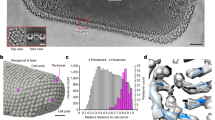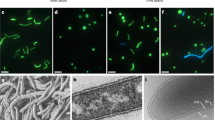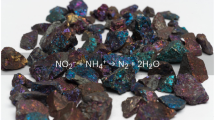Abstract
STUDIES of the amino-acid composition of citrate oxaloacetate lyase (citrate lyase) from Aerobacter aerogenes were made using the pure enzyme prepared by methods previously described1,2. The amino-acid composition of the enzyme was determined using the technique of high-voltage electrophoresis to separate the amino-acids in a protein hydrolysate3. Hydrolysates of two quantities of enzyme (5.0 mg), by ‘AnalaR’ hydrochloric acid (6 N) in sealed tubes at 110° for 24 h and 72 h, respectively, were prepared. The protein in the solution to be hydrolysed was estimated by the method of Hoch and Vallee4. The method of amino-acid separation and analysis was similar to that used by Atfield and Morris5, using a cadmium ninhydrin reagent. The apparatus was based on the general design of Gross6, with longer coiling plates, as favoured by Atfield and Morris5. The concentration of each amino-acid, after elution from the strip, was read from concentration-absorbancy graphs previously constructed using similarly treated standard solutions of amino-acids. Absorbancies were read on a Unicam SP 600 spectrophotometer at 505 mµ. The relative colour values of the cadmium ninhydrin complexes with individual amino-acids on a molar basis are given in Table 1; they show wide variations (cf. Helimann et al.7). Proline was estimated in the hydrolysate, and hydroxyproline shown to be absent, by estimation with cadmium isatin reagent.
This is a preview of subscription content, access via your institution
Access options
Subscribe to this journal
Receive 51 print issues and online access
$199.00 per year
only $3.90 per issue
Buy this article
- Purchase on Springer Link
- Instant access to full article PDF
Prices may be subject to local taxes which are calculated during checkout
Similar content being viewed by others
References
Sivaraman, C., Biochim. Biophys. Acta, 52, 212 (1961).
Bowen, T. J., and Rogers, L. J., Biochim. Biophys. Acta, 67, 633 (1963).
Michl, H., Chrom. Revs., 1, 11 (1958).
Hoch, F. L., and Vallee, B. L., Anal. Chem., 25, 317 (1953).
Atfield, G. N., and Morris, C. J. O. R., Biochem. J., 81, 606 (1961).
Gross, D., J. Chrom., 5, 194 (1961).
Helimann, J., Barrollier, J., and Watzke, E., Z. Physiol. Chem., 309, 219 (1957).
Smith, E., J. Biol. Chem., 207, 501 (1954).
Goodwin, T. W., and Morton, R. A., Biochem. J., 40, 628 (1946).
Beaven, G. H., and Holiday, E. R., Adv. in Protein Chemistry, 7, 319 (1952).
Hotchkiss, R. D., J. Biol. Chem., 141, 171 (1941).
Hrabetova, E., and Tupy, J., J. Chrom., 3, 199 (1960).
McMeekin, T. L., Groves, M. L., and Hipp, N. J., J. Amer. Chem. Soc., 71, 3298 (1949).
Author information
Authors and Affiliations
Rights and permissions
About this article
Cite this article
BOWEN, T., ROGERS, L. Amino-acid Composition and Partial Specific Volume of Citrate Oxaloacetate Lyase. Nature 205, 1316–1317 (1965). https://doi.org/10.1038/2051316a0
Issue Date:
DOI: https://doi.org/10.1038/2051316a0
This article is cited by
-
Bacterial citrate lyase
Journal of Biosciences (1984)
Comments
By submitting a comment you agree to abide by our Terms and Community Guidelines. If you find something abusive or that does not comply with our terms or guidelines please flag it as inappropriate.



